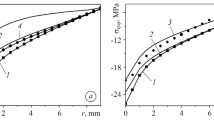A system of basic key equations for the components of hydrogen-induced stresses in a hollow cylindrical metal body is formulated from the viewpoint of the elasticity theory. The corresponding computational formulas are obtained. The components of the tensor of hydrogen-induced stresses are determined.




Similar content being viewed by others
References
V. A. Goltsov, Zh. L. Glukhova, and A. L. Redko, “Hydrogen elasticity effect and its importance in diffusion of concentration inhomogeneities in metals,” Int. J. Hydrogen Energy, 22, 179–183 (1997).
V. A. Goltsov, Zh. L. Glukhova, and O. A. Minakova, “Hydrogen elasticity phenomenon: Experimental manifestations and theory,” J. Alloys Compound., 404–406, 576–579 (2005).
Zh. L. Glukhova, V. A. Goltsov, T. A. Schegoleva, E. N. Lyubimenko, and R. V. Kotelva, “Mathematical modeling of hydroelastic effect of slowing down of diffusion processes in metal-hydrogen system,” Int. J. Nucl. Hydrogen Prod. App., No. 4, 334–342 (2008).
Y. Liang, P. Sofronis, and R. H. Dodds, jr., “Interaction of hydrogen with crack-tip plasticity: effects of constraint on void growth,” Mat. Sci. Eng., 366, 397–411 (2004).
H. R. Sinning, “The intercrystalline Gorsky effect,” Mat. Sci. Eng., 370, 109–113 (2004).
S. Vengallatore, “Gorsky damping in nanomechanical structures,” Scripta Mater., 52, 1265–1268 (2005).
M. H. Stashchuk, “Mutual influence of the stress-strain state and hydrogen concentration in the metal-hydrogen system,” Fiz.-Khim. Mekh. Mat., 47, No. 4, 71–77 (2011); English translation : Mater. Sci., No. 4, 499–508 (2011).
M. H. Stashchuk and M. I. Dorosh, “Evaluation of hydrogen stresses in metal and redistribution of hydrogen around crack-like defects,” Int. J. Hydrogen Energy, 37, 14687 –14696 (2012).
N. M. Vlasov and I. I. Fedik, “Hydrogen segregation in the area of threefold junctions of grain boundaries,” Int. J. Hydrogen Energy, 27, 921–926 (2002).
O. E. Andreikiv and O. V. Hembara, Fracture Mechanics and Durability of Metallic Materials in Hydrogen-Containing Media [in Ukrainian], Naukova Dumka, Kiev (2008).
A. T. Yokobori, jr., T. Nemoto, K. Satoh, and T. Yamada, “Numerical analysis on hydrogen diffusion and concentration in solid with emission around the crack tip,” Eng. Fract. Mech., 55, 47–60 (1996).
B. Rupp, “On the change in physical properties of Ti4–x Fe2+x O y during hydrogenation. 1. Activation behavior of ternary oxides Ti4–x Fe2+x O y and β -Ti,” J. of Less-Comm. Metals, 104, 51–63 (1984).
G. Alefeld and J. Völkl (editors), Hydrogen in Metals. Application-Oriented Properties, Springer, Berlin (1978), Vol. 2.
N. I. Muskhelishvili, Some Basic Problems of the Mathematical Theory of Elasticity, Noordhoff, Groningen (1953).
H. S. Carslaw and J. C. Jaeger, Conduction of Heat in Solids, Oxford Univ. Press, New York (1959).
V. I. Shapovalov, Alloying with Hydrogen [in Russian], Zhurfond, Dnepropetrovsk (2013).
M. Farzam, “Hydrogen degradation of steel-diffusion and deterioration,” Iran. J. Sci. Tech., 28, 255 – 263 (2004).
J. Capelle, J. Gilgert, I. Dmytrakh, and G. Pluvinage, “Sensitivity of pipelines with API X52 steel to hydrogen embrittlement,” Int. J. Hydrogen Energy, 33, 7630–7641 (2008).
Author information
Authors and Affiliations
Corresponding author
Additional information
Translated from Fizyko-Khimichna Mekhanika Materialiv, Vol. 51, No. 4, pp. 76–83, July–August, 2015.
Rights and permissions
About this article
Cite this article
Stashchuk, M.H., Dorosh, M.I. Evaluation of Stresses Caused by Hydrogen Concentrated in the Metal. Mater Sci 51, 520–529 (2016). https://doi.org/10.1007/s11003-016-9871-y
Received:
Published:
Issue Date:
DOI: https://doi.org/10.1007/s11003-016-9871-y




